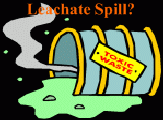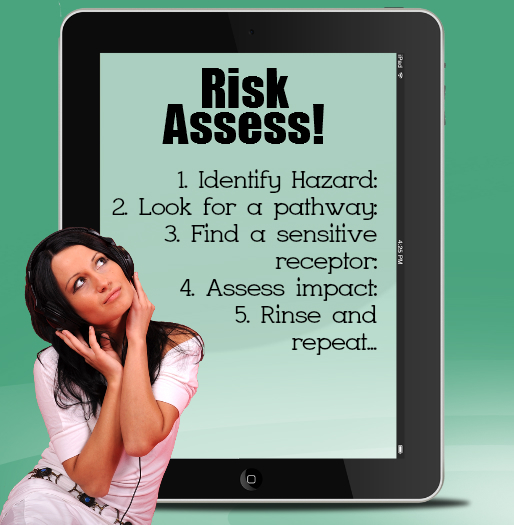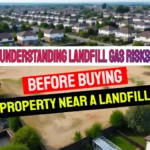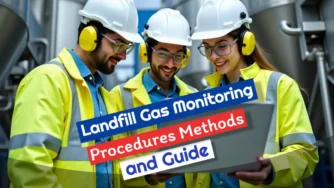Landfill site emissions risk assessments are a mandatory requirement for environmental permit applications (previously known as Landfill Site PPC Applications). They identify possible hazards to the environment and public health from landfill gas and leachate. The procedure calls for a thorough examination of landfill emissions, including assessments of the effects on the air, groundwater, and surface water. Identification of receptors, modelling of consequences, evaluation of control strategies, and proving acceptable residual environmental risk are important elements.
We thought that we would provide this article on the philosophy of risk assessment, which underpins the selection and design of the emissions control measures that landfill operators are required  to implement.
to implement.
The purpose of each risk assessment is to demonstrate that suitable control measures have been included in the landfill design and the operating plan to comply with all applicable regulations and comply with the EU directives.
Each risk assessment will need to begin by stating:
- The purpose of the risk assessment
- What the risk assessment needs to demonstrate
- What exactly needs to be assessed and how?
If a risk assessment (RA) is to be accepted by the Environment Agency (UK), it will need to provide a suitable level of confidence that the risk will be either avoided entirely or the potential effect ameliorated in a manner resulting in a suitably low residual risk.
To submit a PPC Permit Application, risk assessments will need to be prepared to cover the following general subjects, for most sites:-
- Hydrogeological risk assessment
- Landfill gas emissions
- Emissions to controlled waters
- Slope stability
- Third-party nuisance
- Habitat
- Health & safety.
Hydrogeological risk assessment
 The Hydrogeological Risk Assessment (HRA) is based upon detailed topographical, geological, and hydrogeological data collected at the site and from the surrounding area. It will provide sufficient information to allow the sensitivity of the local groundwater to pollution to be modelled and assessed for the emissions control requirements..
The Hydrogeological Risk Assessment (HRA) is based upon detailed topographical, geological, and hydrogeological data collected at the site and from the surrounding area. It will provide sufficient information to allow the sensitivity of the local groundwater to pollution to be modelled and assessed for the emissions control requirements..
In some areas, where, for example, the geology comprises deep clay with no significant groundwater flow, the sensitivity of the site to pollution will be low. However, the opposite would clearly be the case for a large landfill located above sands and gravels, close to a river and drinking water abstraction wells.
The hydrogeological context and general sensitivity to pollution are then used within the HRA to show that the type of geological barrier, the mineral and membrane layers, and also the leachate sealing and drainage system, are designed to parameters which will appropriately minimise risk.
Landfill gas emissions risk assessment
A landfill gas emissions control risk assessment, similar to many others, will follow a source – pathway – receptor identification sequence.
The source term is the starting point. Start by defining the trace compounds present in landfill gas and in emissions from flares and engines.
- Identify all point source emissions. These include vents, flare stacks, engine exhausts etc.
- Identify all diffuse emissions. These include the surface of the waste, cover and capping.
Follow this through into the impact assessment for landfill gas emanating from each source.
Impacts, which must be considered, and if necessary ameliorated (reduced) will include:
- Health
- Odour
- Greenhouse gases.
Emissions to controlled waters risk assessment
Identify the sensitive receptors for emissions control:
- Identify and place in context the potential impact of any Dangerous Substances which may remain in any discharge (previously known as List I & II substances, and as “Red List” substances before that.)
- State how compliance will be achieved with the groundwater regulations, etc
- Compliance with the engineering specification in the Landfill Regulations must also be shown.
The Controlled Waters Risk Assessment will apply to all sites in wet geographical areas, where there is a net excess of water shown in the site water balance. The risk to controlled waters also needs to be discussed in terms of the:
Source-term with maximum contaminant concentrations for:
- Inert waste
- Non-hazardous wastes
- Hazardous wastes
- Lining design, including thickness, cation exchange capacity, availability of organic iron, and permeability (if not already exhaustively covered by the HRA)
- Leachate head (if not already exhaustively covered by the HRA)
- Geology/hydrogeology (if not already exhaustively covered by the HRA).
The assessment of the necessary emissions control, for the controlled waters risk assessment (CWRA), should also look at failure scenarios, requiring study of the waste infilling operation, and (for existing sites) commenting on work to date. The main scenarios, which normally require reporting, are:
- Capacity of drainage systems
- Leachate head
- Liner stability
- Derivation of the liner specification in terms of the capacity of local drainage systems, and treatment at the Wastewater Treatment Works (Sewage Works).
- Derivation of compliance and of data requirements for compliance monitoring.
Slope stability risk assessment and emissions control
The waste industry's record for compliance with slope stability requirements has not been good in recent years. One major reason may be that a risk assessment process has not always been used to look at all risks inherent in the installation of modern lining systems. Hence, the necessary attention to a holistic approach to the selection of all potential slip planes has been found wanting on many  occasions.
occasions.
For example, a soils engineer will not necessarily fully explore slips along the liner/clay interface, or fully allow for the negative effect of waste saturation on stability, unless the risk of such occurring is highlighted by the specialist waste designer's risk assessment.
Without such involvement, the soils engineer may omit such emissions control considerations.
Major considerations in waste slope stability calculations are therefore risks assessed in respect of the following:
- Base strata
- Engineered fill and variations in structural properties
- Groundwater drainage systems/influence on pore water pressures
- Liner components and interaction with soils or between components (single or composite)
- Waste quality variations – particularly related to water content at “worst case” scenarios
- Cap and restoration soils
- Strength parameters for the waste at the degree of compaction to be applied, groundwater levels, and leachate levels.
A structural failure of a slope may lead to uncontrolled emissions. A risk assessment of these should be conducted to show that these are of negligibly low risk, or that worst-case scenarios present an acceptably low environmental risk.
Such worst cases should include:
- disruption of the liner or cap, and gas and leachate control systems
- stability of slopes
- stability due to settlement from mining
- stability due to movement at geological faults.
Third Party Nuisance Risk Assessment
Start by adopting a risk screening methodology to identify all potential hazards, and rapidly eliminate all those third-party nuisance hazards which are very low risk, giving broad reasons for not considering these further.
A good way in to do this is to build up a risk matrix to identify all site-specific hazards.
Start by identifying the site-specific sensitive receptors, and the stages that follow are:
- qualitatively assess the risk to each sensitive receptor
- Identify suitable risk management measures
- identification of monitoring requirements
- identification of the need for more detailed risk assessment.
Those subjects which would normally require more detailed analysis and discussion, and proposals for ameliorative risk management measures, include:
- Noise & vibration
- Particulates (dust, aerosols)
- Odour
- Litter
- Birds
- Vermin and insects
- Mud on public roads
Habitat Risk Assessment
This risk assessment work will be heavily guided by the measures required to implement the Conservation (Natural Habitats etc) Regulations 1994.
The regulations have been implemented in order to protect a range of sites for the habitat or species 
The aim is to identify such measures as necessary to demonstrate that no adverse effect will be caused to these sites as a result of the landfill activities.
The sites falling under EU Directive requirements are numerous, and the applicable directives are:-
- Special Protection Areas under the Wild Birds Directive
- Designated and candidate Special Areas of Conservation under the Habitats Directive (applies to England only at present)
- RAMSAR sites under the RAMSAR Convention on Wetlands of International Importance
The habitat assessment should include all within a 5km radius of a landfill, and the risk level of each potential impact identified as high, low, or medium priority based on each impact. Each will be tested for relevance, significance of effect, and adverse effect. Again, the source > pathway > receptor methodology will apply.
Health & Safety Risk Assessment
Last but not least is Health & Safety, and the first to be brought into the risk assessment process are the statutory consultees:
- Primary Care Trusts
- Local Health Boards.
The primary task of this stage is to ensure that all exposure routes have been properly assessed and considered, and if necessary, the plans modified.
Most (and possibly all) of the potential health risks will already have been considered by this point, in the preceding Risk Assessments. However, the inclusion of this section should be a catch-all section for the remaining Health & Safety issues, which may arise, but which might not be identified anywhere else.
Conclusion
Risk is assessed for every potential impact – in order to apply for a UK Landfill Site PPC Application, and that's not a bad thing, as the solutions which evolve as a result will have the best chance that can possibly be devised to make them relevant.
[Published Nov 24, 2012. Updated September 2025.]
UK Landfill Gas Emissions Control
The Stringent EA Controls, Which Limit UK Landfill Gas Emissions to Minimise the Emission of Carbon Dioxide thought to be a Significant Cause of Climate Change The UK waste management industry is required to control landfill gas emissions to a high standard. The Environment Agency (EA) is responsible for regulating landfills and ensuring that all […]
Understanding Landfill Gas Risks Before Buying Property Near a Landfill
Buying Real Estate: Understand Landfill Gas Risks before buying land near a landfill! Landfill sites can produce methane, and that can continue for many years. It has been a known issue for years. Site operators used to see small landfill gas fires as minor problems when they first started to happen in the 1970s in […]
UK Landfill Gas Emissions – Stringent EA Controls Implemented
The waste management industry is required to control UK landfill gas emissions to a high standard. The Environment Agency (EA) ensures that all licensed (closed) or permitted landfill sites which contain landfill gas are regulated to ensure that emissions are kept to a minimum. This is enforced either under the pollution prevention and control (PPC) […]
Landfill Gas Migration Defined and Explained
Landfill gas migration is defined as the process which occurs when the landfill gas generated within a landfill moves from the site of original waste deposition out of the landfilled waste, into the surrounding environment. This may take place as a result of the gas flow induced by the positive gas pressure produced by the […]









Hi. I have checked your landfill-gas.com and i see you’ve got some good information here. where can I get these risk assessments done?
I always insist my fellow viewers to continuously update themselves through safety education. I strongly believe that , the safety can be achieved only through the detailed analysis of all risks. Thank you for your contribution towards excellence in safety.
Bureaucratic crazy nonsense. Do you guys get out of bed without a Risk Assessment?